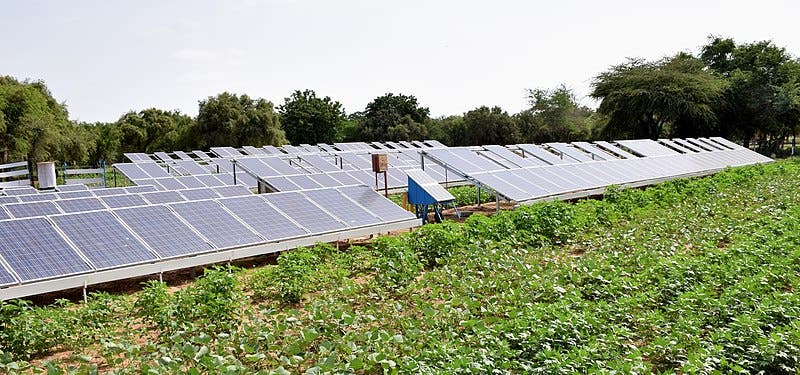Solar energy is not only compatible with agriculture — it can actually be beneficial.

Two of the world’s most pressing challenges are ensuring food security and renewable energy for the globe’s population. At first glance, it would seem that the two don’t play well together. Take solar panels: they produce electricity from solar energy — the same energy which plants need for photosynthesis. So then how could the two work together? According to a new study, it’s possible thanks to an overabundance of solar energy.
Agrivoltaics, which relies on solar sharing, is the idea that solar panels and crops can work well together. The idea has been gaining a lot of traction and interest lately, but few studies have monitored all the aspects of the associated food, energy, and water systems.
“So which land use do you prefer — food or energy production? This challenge strikes right at the intersection of human-environment connections, and that is where geographers shine!” said Greg Barron-Gafford, an associate professor in the School of Geography and Development and lead author on the paper that was published today in Nature Sustainability. “We started to ask, ‘Why not do produce both in the same place?’ And we have been growing crops like tomatoes, peppers, chard, kale, and herbs in the shade of solar panels ever since.”
In order to address this issue, the team lead by Barron-Gafford worked on Biosphere 2 — an American Earth system science research facility located in Oracle, Arizona. Biosphere 2 was originally meant to demonstrate the viability of closed ecological systems to support and maintain human life in outer space, but it has since become a center for research and outreach related to Earth science.
Biosphere 2 is also located in the American Southwest — an area known for its hot and dry weather. Water is a scarce commodity, and things are only going to get worse due to climate heating. No other study has assessed the feasibility of agrivoltaics in such an environment, so it was an excellent place to start. The first problem is location, researchers say.
“Many of us want more renewable energy, but where do you put all of those panels? As solar installations grow, they tend to be out on the edges of cities, and this is historically where we have already been growing our food,” said Barron-Gafford, who is also a researcher with Biosphere 2.
The study focused on chiltepin pepper, jalapeno and cherry tomato plants — regional plants. Three plots were set out for the summer months: one with solar panels, one with crops, and one with both. Throughout the study, researchers continuously monitored incoming light levels, temperature, and humidity using sensors mounted above the surface. They also measured subsurface temperature and moisture at a depth of 5 centimeters. The solar panels were mounted 3 meters high — a bit taller than usual.
The idea wasn’t just that the solar panels and crops could co-exist, but that they could actually help each other. In the torrid Arizona sun, the shade provided by solar panels lowered the surface temperature and reduced evaporation, which helped the crops. Similarly, the plants would help keep the panels just a little cooler, which actually helps produce more electricity (since solar panel efficiency drops with high temperatures).
Air temperatures were on average 1°C cooler during the day on average, but they also stayed about 0.5°C warmer overnight. Meanwhile, the temperature of the solar panels dropped by 9°C due to the plants growing beneath them. This amounts to an increase in efficiency of 3% over the summer months and 1% for the entire year.
As for the plants, the results were simply remarkable.
“We found that many of our food crops do better in the shade of solar panels because they are spared from the direct sun,” Baron-Gafford said. “In fact, total chiltepin fruit production was three times greater under the PV panels in an agrivoltaic system, and tomato production was twice as great!”
Not all plants benefited equally, however, The Jalapeños took up 11% less CO2 under the panels, which suggests that they missed the extra sunlight. However, the jalapeño crops under the solar panels produced just as much as those without solar panels, but they used 65% less water due to reduced transpiration.
The cherry tomatoes saw a 65% increase in CO2 uptake and a 65% increase in water-use efficiency — while producing twice as many tomatoes.
More research is still required on other species, but this study is extremely encouraging. It not only showcases that solar energy and plants can help each other, potentially opening the way for sustainable agrivoltaics facilities. In addition to further research, the team is already working on adding such installations to multiple schools. Getting people more interested in what happens in their community is an important dynamic if we want to implement sustainable shifts in society, he concludes.
“What draws me to this work is what happens to the K-12 learner when their involvement is consequential and the research lives in their community,” said Dr. Moses Thompson, one of the research authors. “That shift in dynamics creates students who feel agency in addressing grand challenges such as climate change.”
Journal Reference: Greg Barron-Gafford et al. Agrivoltaics provide mutual benefits across the food–energy–water nexus in drylands. Nature Sustainability, 2019; DOI: 10.1038/s41893-019-0364-5





